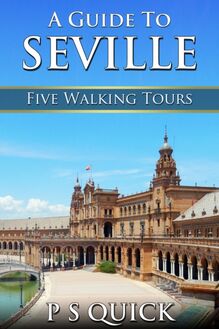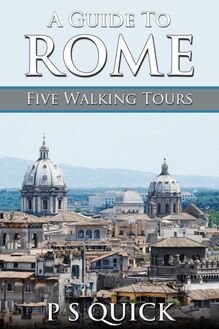Guide to Puglia , livre ebook
45
pages
English
Ebooks
2017
Vous pourrez modifier la taille du texte de cet ouvrage
Obtenez un accès à la bibliothèque pour le consulter en ligne En savoir plus
Découvre YouScribe en t'inscrivant gratuitement
Découvre YouScribe en t'inscrivant gratuitement
45
pages
English
Ebooks
2017
Vous pourrez modifier la taille du texte de cet ouvrage
Obtenez un accès à la bibliothèque pour le consulter en ligne En savoir plus
Publié par
Date de parution
20 avril 2017
Nombre de lectures
4
EAN13
9781785386572
Langue
English
Poids de l'ouvrage
2 Mo
Publié par
Date de parution
20 avril 2017
Nombre de lectures
4
EAN13
9781785386572
Langue
English
Poids de l'ouvrage
2 Mo
A Guide to Puglia
Five Walking Tours
P S Quick
Published in 2017 by
Acorn Books
www.acornbooks.co.uk
an imprint of
Andrews UK Limited
www.andrewsuk.com
Copyright © 2017 P S Quick
The right of P S Quick to be identified as the Author of this Work has been asserted in accordance with the Copyright, Designs and Patents Act 1998
All rights reserved. No part of this publication may be reproduced, stored in a retrieval system, or transmitted, in any form or by any means without the prior written permission of the publisher, nor be otherwise circulated in any form of binding or cover other than that in which it is published and without a similar condition being imposed on the subsequent purchaser. Any person who does so may be liable to criminal prosecution and civil claims for damages.
All information provided in this guide is correct at the time of publication. If anything is subsequently found to be incorrect, please advise the publishers who will update the text in future editions.
Introduction
Although not one of Italy’s top tourist destinations Puglia is beginning to attract tourists to its varied charms. Once just the area where travellers arrived or departed for Greece, Albania and Croatia, Puglia is becoming appreciated for its own attractions. This area in the heel of Italy’s boot has a rich historic past. Originally a humble farming region it has been influenced by Greeks, Romans, Normans and Byzantines who each made an impact on the landscape by building ports, churches and other magnificent buildings.
This book aims to give the tourist an opportunity to visit and enjoy not only the few major attractions that a guided tour usually includes but many of the other interesting sights that other people do not see. By providing five different walking routes and detailed information about each attraction passed it puts a visitor to Puglia in charge of the time spent at any particular place rather than having to rush and keep up with a guide or join costly tours.
These five walks will enable you to experience the variety and atmosphere of some wonderful contrasting destinations in Puglia. You will be surprised to discover the rich historical monuments of Brindisi and astounded by the Baroque architecture of Lecce; you’ll marvel at the unique construction of the Trulli of Alberobello and be transported back in time when exploring the Sassi of Matera.
Preparation Puglia has a wonderful Mediterranean climate with short mild winters but the summers can be intensely hot and dry. Plan your trip according to the activities you wish to experience. If you visit in summer, particularly in July and August when temperatures can reach 30° and above, you will need to escape the sun for at least part of the day and may not see all you wish. April and May or September and October are good for sightseeing. The coldest month is January but it is still mild with an average of 10° while November is the wettest month. If you enjoy the pomp and ceremony of festivals then Puglia has a number throughout the year especially around Eastertime. Check online to confirm the festival’s dates as they vary from year to year. Visit a tourist office as soon as you can on arrival to pick up details of attractions and opening times together with a free map which is essential in order to get your bearings and understand where places are located. Remember that Puglia is still developing as a tourist destination so there may be fewer resources available than in the more popular resorts of Italy. Hotels sometimes have free maps and other information for their clients. Do your research and read through this guide in order to decide which museums or other places you want to go into before leaving home. Puglia has some excellent museums that reflect its history and cultural heritage. Many are closed on Mondays so it is worth checking the opening times. There will also be variations depending upon the time of year. In the south of Italy almost everything closes for lunch and does not reopen until late afternoon. Puglia has some wonderful places to take refreshment and try a range of local wines or food specialities such as burrata and pettola. While it is wonderful to sit and enjoy a drink or meal in the busy plazas next to top attractions this can be expensive. You will find some good quality tapas bars, cafes and restaurants off the main streets. Ask your hotel where the locals eat for the best deals. Transport links to the area are improving. It is possible to fly into Bari or Brindisi airport from where there are coaches and trains to many of the surrounding towns so hiring a car is not essential although can be useful for some of the smaller destinations. Public transport within some smaller towns is limited. You will see much more and absorb the atmosphere of the places in this guide if you can walk around the sites. However, some of the destinations such as Matera can be quite challenging if you have problems with walking. Most tours in this book are quite intense so you may want to spread some over two days. If you can, try to stay for a night in each of these destinations and enjoy the extra time. Spending a night in a Trulli in Alberobello or a Sassi cave in Matera will be an experience never forgotten. Prepare for your trip by trying to learn a few Italian words. Take a phrase book with you because in this area of Italy many people will not understand much English. Print out all your travel details and write a few things down in Italian so that you can show to people if you have any difficulties. The people are friendly and very willing to help.
The First Tour: Brindisi
Known as the Gateway to the East since ancient times when it was an important port for Roman troops and later for Venetian merchants Brindisi has played a significant role in trade and culture. Today the city is a major port not only trading with the Middle East and Greece but also providing important travel connections by sea, air and train. There are good transport links to many of the other interesting towns in Puglia from Brindisi.
Many people view Brindisi merely as a location for arrivals and departures but Brindisi is a city worth exploring. It has a rich history that goes back to Greek and Roman times with two columns erected to pinpoint ancient Brindisi known as Brundisium as the end of the Appian Way. Since then it has passed to the Ostrogoths, the Byzantines, the Lombards, the Saracens and then the Normans. Brindisi became the port from where the Crusaders departed. Emperor Frederick II set off to the Sixth Crusade from this port and reclaimed Jerusalem for the Christians.
Brindisi was badly bombed during World War II and today’s city is significantly different from the past. The seafront promenade is filled with restaurants and bars, the town centre has beautiful wide tree lined streets and yet the old part of the town still retains its winding streets filled with Baroque churches. The impressive fortress or Castello Svevo named after Emperor Frederick II now belongs to the Navy so cannot be visited. It has not been included in this tour but if you have time to spare then walk around the outside on another occasion.
Today’s tour begins at the Piazza Santa Teresa then visits the tourist office in order to pick up a map before exploring the older parts of the town. It takes you through winding city streets where you will see architecture that spans centuries with churches, palaces, plazas, Roman columns and walls and the old city gates. The tour ends at Porta Lecce where you can also visit the Chiesa del Cristo.
Main Sights Piazza and Chiesa di Santa Teresa Monumento ai Caduti d’Italia Casa del Turista Colonne Romane Piazza Vittorio Emanuele II Piazza Della Vittoria Saint Pietro of Schiavoni Archeological Area Palazzo Granafei Nervegna Loggia del Palazzo Balsamo Cattedrale di San Giovanni Battista Seminario Arcivescovile Portico de Cavalieri Templari Museo Archeologico Provinciale “Francesco Ribezzo” San Giovanni Al Sepolcro Chiesa San Benedetto Porta Mesagne e Bastione Aragonese Piazza Cairoli Porta Lecce e Bastione di Levante Chiesa del Cristo
Piazza Santa Teresa
The large Square of Saint Teresa is located to the north of the old town and overlooks the seafront. From here there are steps leading down to the waterfront promenade. In the square you will find a monument to the fallen of World War I, the Church of Saint Teresa and a convent that now houses the state archives. The semi-circular Empire Fountain, also known as the Monumental Fountain, was built in 1940 and stands on the rounded outer part of the square.
Monumento ai Caduti d’Italia
In the centre of the square stands a striking memorial to the fallen Italians of World War I built from white Carrara marble by the local sculptor Edgardo Simone. The sculpture was originally intended for the railway station but has been moved a number of times as the sculptor thought the locations too trivial.
The figure at the top represents victory. In her right hand she holds a dagger with laurel and oak while in her left the city of Rome. A dying warrior holding a Roman shield carved with the head of Medusa lies at her feet. There are two figures that stand on either side. On the left is a mother sending her son off to war while on the right a mother has her arm around a young child and sits with her head bowed in grief. A record of all the major battles that Italy fought in World War I is engraved on the rear pedestal.
Chiesa Santa Teresa
On the eastern side of the square stands the Baroque Church of Saint Teresa with



